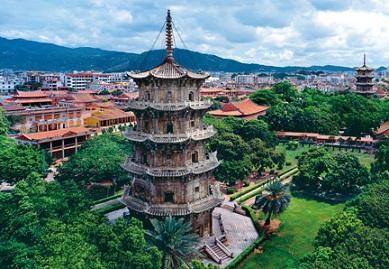Mahan Altaf

My two weeks in Xiamen was an experience never to be forgotten. My first impressions of Xiamen, from the drive from the airport to Xiamen University campus, was that, this is not the China that is portrayed on T.V. I was taken aback at how modern, clean and structured this city is. The weather was absolutely scorching, but I got used to it, as time went on.
I really enjoyed learning about the Chinese culture and economy. It was a lovely insight in to the Chinese world. The lectures we had, were educational, yet enjoyable and a pleasure going to. The Chinese cultural experiences and field trips were captivating. Each field trip and cultural experience were exceptional in their own right. Overall, I am glad I was able to attend the summer school, I do not think you would get this kind of opportunity anywhere else after university.
Our summer school started with a lovely introduction by the head of the department and this was followed by a scavenger hunt, where we were given tasks on a A4 piece of paper, that we had to complete within two and a half hours around the beautiful campus. The afternoon and evening entailed of our first lecture, which was about labour economics and China’s growth prospects, which was taught by Professor Lei Meng and a welcome dinner organised by our very accommodating hosts. The food was very interesting. This was followed by going to the basketball courts and shooting some hoops. I was very surprised to see the basketball courts so full at the time of playing.
The next day started off with a Martial Arts Workshop, our first Chinese Cultural Experience. This was a great opportunity to show off my inner ‘Bruce Lee’. We were taught by the highly skilled Professor Guangbo Yang. We learnt a series of choreographed moves which then involved battling out in pairs. The end result looked like something out of Enter the Dragon. On Wednesday 3rd July, we visited the Nanputuo Temple, just located nearby the university campus. The temple was founded in the Tang dynasty. The temple had a quiet and calm atmosphere, which was surprising as they were a lot of people in attendance. Behind the temple, there was a climb which comprised of 48 levels which led to a very steep summit. The view at the top was not all that great, because it was blocked off by a tree, however, the views at the different levels were remarkable. I was able to see quite a bit of Xiamen and Gulangyu Island. The summit, I believe, was called the Five-Old-Man peak.
On Friday 5th July, we visited Gulangyu Island. It is situated just off the coast of Xiamen. The island is a pedestrian only island and bans cars and bicycles, only electric buggies are allowed. The only way to get to the island is by a ferry. The ferry port looked like an airport terminal, a lot of security and very busy. I was told that there was some sort of shopping centre on the second floor, I unfortunately did not have the time to explore that area, as I had a ferry to catch to Gulangyu Island.
When we arrived at the “Piano Island”, I was immediately greeted by the native mosquitos. Once I had squished the hosts, I set off my way and explored the streets of Gulangyu Island. The building structures and architecture of this island is very different to that of China’s, I had forgotten I was walking on Chinese soil. The architecture seemed it was from the Victorian-era in England, as many foreign residents did seem to settle here during that time.
A trip to Quanzhou then followed the next day. We got up bright and early, something I had gotten used over the course of summer school, headed to the coach and set off on our two-hour voyage to Quanzhou. The city of Quanzhou was a complete contrast to Xiamen Island. I had gotten use to the new, artificial city, and so the visit to Quanzhou was a breath of fresh air, figuratively not literally. We first visited the Kaiyuan temple, the largest one in the Fujian province. It was built in the Tang dynasty and had a heavy South Indian influence, which you could see in the building carvings. After the visit to the temple, we set off for lunch. After which, we headed off to another temple. The temple had a large area of free space, and a pond filled with exotic fishes. The temple also had a big statue of the famous philosopher, Confucius. After that, we visited the Qingjing Mosque which was built in 1009, and had a heavy Arab architectural style to it, it was designed after the mosque in Damascus of Syria and built with pure granite. Many of the gate’s domes are carved with hanging lotus’, symbolising the respect for purity and sanctity. After spending some time there in the mosque, we then went to the final destination on our trip, the Quanzhou Maritime Museum. It is the only museum in China specialising in overseas relations.
If I had a chance to go again to China, I would not hesitate at the opportunity.
